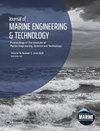Numerical investigation on hydrodynamic performance of shaftless rim-driven thruster
IF 4.4
4区 工程技术
Q1 ENGINEERING, MARINE
Journal of Marine Engineering and Technology
Pub Date : 2023-10-11
DOI:10.1080/20464177.2023.2266886
引用次数: 0
Abstract
AbstractAs a new type of propulsion method, the shaftless rim-driven thruster (RDT) has become a research hotspot for ship propulsion due to the absence of the propeller propulsion shaft system setting and the advantages of small cabin occupancy, low noise and low vibration. Numerical investigations were performed to study the effect of blade inclination angle on the hydrodynamic performance of shaftless Rim-driven Thruster. To verify the feasibility of the simulation method, the No.19A + Ka4-70 duct propeller was analysed first and the geometric model of the RDT for the hydrodynamic properties was established in reverse engineering. The hydrodynamic performance of the shaftless rim thruster was studied based on the RANS method, and the performance data of this shaftless rim thruster at each inlet speed coefficient were obtained. Additionally, the characteristics of the change in the inclination angle of the blade relative to its centre axis were examined and the effect of the change in inclination angle on the hydrodynamic performance of the shaftless rim thruster was investigated. Additionally, the numerical calculation results show that a five degree increase in the Z-axis circumferential inclination results in the increase of all the hydrodynamic coefficients of the RDT. Among them, the total thrust is increased by about 14%, the total torque is increased by about 15% and the total efficiency is also comparable to the original thruster efficiency. AcknowledgementWe would like to thank the Zhejiang Province Public Welfare Technology Application Research Project (LGG22E080020), Healthy & Intelligent Kitchen Engineering Research Center of Zhejiang Province (ZFGGJ2021-389), 2025 Major Programs on Science Technology Innovation of Ningbo (2020Z06) and National “111” Centre on Safety and Intelligent Operation of Sea Bridges (D21013) for their support for this research.Disclosure statementNo potential conflict of interest was reported by the author(s).Additional informationFundingThis work was supported by the Zhejiang Province Public Welfare Technology Application Research Project [grant number LGG22E080020]; 2025 Major Programs on Science Technology Innovation of Ningbo [grant number 2020Z06]; Healthy & Intelligent Kitchen Engineering Research Center of Zhejiang Province.Notes on contributorsLiang PengLiang Peng, Doctoral students, Faculty of Maritime and Transportation, Ningbo University.Changfa WangChangfa Wang, Master's student, Faculty of Maritime and Transportation, Ningbo University.Yongqiang TanYongqiang Tan, Master's student, Faculty of Maritime and Transportation, Ningbo University.Yi HuYi Hu, Master's student, Faculty of Maritime and Transportation, Ningbo University.Zhenlei ChenZhenlei Chen, Professor, Faculty of Maritime and Transportation, Ningbo University.Shaohua XiaShaohua Xia, Senior engineer, Ningbo Haibo Group Co. Ltd.Fan ShiFan Shi, Professor, Faculty of Maritime and Transportation, Ningbo University.无轴轮辋驱动推力器水动力性能数值研究
摘要无轴轮缘驱动推力器作为一种新型的推进方式,由于其无需螺旋桨推进轴系设置,且具有舱室占用小、噪声低、振动小等优点,已成为船舶推进领域的研究热点。通过数值模拟研究了叶片倾角对无轴轮辋推力器水动力性能的影响。为了验证仿真方法的可行性,首先对19a + Ka4-70风管螺旋桨进行了分析,并在逆向工程中建立了RDT的水动力特性几何模型。基于RANS方法对无轴轮缘推力器的流体动力性能进行了研究,得到了该无轴轮缘推力器在各进口速度系数下的性能数据。此外,还研究了叶片相对于中心轴的倾角变化特性,并研究了倾角变化对无轴轮缘推力器流体动力性能的影响。此外,数值计算结果表明,z轴周向倾角每增加5度,RDT的所有水动力系数都会增加。其中,总推力提高约14%,总转矩提高约15%,总效率也与原推力器效率相当。感谢浙江省公益技术应用研究项目(LGG22E080020)、浙江省健康与智能厨房工程研究中心(ZFGGJ2021-389)、宁波市科技创新2025重大专项(2020Z06)和国家“111”海上桥梁安全与智能运行研究中心(D21013)对本研究的支持。披露声明作者未报告潜在的利益冲突。本工作由浙江省公益性技术应用研究项目资助[批准号:LGG22E080020];宁波市科技创新2025重大专项[批准号2020Z06];浙江省健康智能厨房工程研究中心。梁鹏亮,博士生,宁波大学海洋与运输学院。王昌发,硕士研究生,宁波大学海洋与运输学院。谭永强,宁波大学海洋与运输学院硕士研究生。胡毅,硕士研究生,宁波大学海洋与运输学院。陈振磊,宁波大学海洋与运输学院教授。夏少华夏少华,宁波海博集团有限公司高级工程师,宁波大学海运与运输学院教授。
本文章由计算机程序翻译,如有差异,请以英文原文为准。
求助全文
约1分钟内获得全文
求助全文
来源期刊

Journal of Marine Engineering and Technology
ENGINEERING, MARINE-
CiteScore
6.30
自引率
0.00%
发文量
15
期刊介绍:
The Journal of Marine Engineering and Technology will publish papers concerned with scientific and theoretical research applied to all aspects of marine engineering and technology in addition to issues associated with the application of technology in the marine environment. The areas of interest will include:
• Fuel technology and Combustion
• Power and Propulsion Systems
• Noise and vibration
• Offshore and Underwater Technology
• Computing, IT and communication
• Pumping and Pipeline Engineering
• Safety and Environmental Assessment
• Electrical and Electronic Systems and Machines
• Vessel Manoeuvring and Stabilisation
• Tribology and Power Transmission
• Dynamic modelling, System Simulation and Control
• Heat Transfer, Energy Conversion and Use
• Renewable Energy and Sustainability
• Materials and Corrosion
• Heat Engine Development
• Green Shipping
• Hydrography
• Subsea Operations
• Cargo Handling and Containment
• Pollution Reduction
• Navigation
• Vessel Management
• Decommissioning
• Salvage Procedures
• Legislation
• Ship and floating structure design
• Robotics Salvage Procedures
• Structural Integrity Cargo Handling and Containment
• Marine resource and acquisition
• Risk Analysis Robotics
• Maintenance and Inspection Planning Vessel Management
• Marine security
• Risk Analysis
• Legislation
• Underwater Vehicles
• Plant and Equipment
• Structural Integrity
• Installation and Repair
• Plant and Equipment
• Maintenance and Inspection Planning.
 求助内容:
求助内容: 应助结果提醒方式:
应助结果提醒方式:


